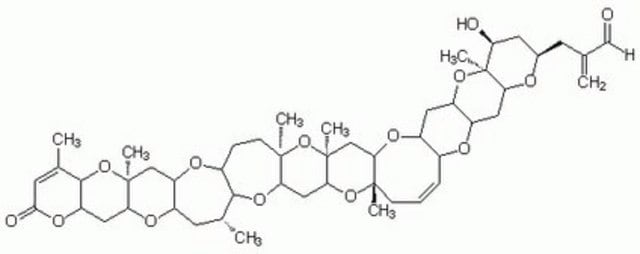203734-M
Brevetoxin PbTx-3, Ptychodiscus brevis
Lipid-soluble polyether marine toxin produced by the red tide dinoflagellate, Ptychodiscus brevis, found along the Gulf Coast of Florida.
Synonim(y):
Brevetoxin PbTx-3, Ptychodiscus brevis, Pumiliotoxin, Dihydrobrevetoxin B
About This Item
Polecane produkty
Poziom jakości
Próba
>95% (HPLC)
Postać
solid
producent / nazwa handlowa
Calbiochem®
warunki przechowywania
OK to freeze
rozpuszczalność
ethanol: 10 mg/mL
DMSO: 30 mg/mL
acetonitrile: 30 mg/mL
chloroform: 30 mg/mL
methanol: 30 mg/mL
water: sparingly soluble
temp. przechowywania
−20°C
InChI
1S/C50H72O14/c1-25(24-51)14-28-17-37(52)50(8)41(54-28)19-33-34(61-50)18-32-29(55-33)10-9-12-46(4)42(58-32)23-49(7)40(62-46)21-39-47(5,64-49)13-11-30-44(60-39)26(2)15-31-36(56-30)22-48(6)38(57-31)20-35-45(63-48)27(3)16-43(53)59-35/h9-10,16,26,28-42,44-45,51-52H,1,11-15,17-24H2,2-8H3/b10-9-
Klucz InChI
BKMHDYJRAAJTAD-KTKRTIGZSA-N
Opis ogólny
Działania biochem./fizjol.
Voltage-dependent Na+ channel activator
Ostrzeżenie
Rekonstytucja
Inne uwagi
Rein, K., et al. 1994. J. Org. Chem.59, 2107.
Edwards, R.A., et al. 1992. Mol. Brain Res.14, 64.
Trainer, V.L. 1991. Mol. Pharmacol.40, 988.
Tsai, M.C., and Chen, M.L. 1991. Br. J. Pharmacol.103, 1126.
Trainer, V.L., et al. 1990. ACS Symposium Series418, 166.
Baden, D.G., et al. 1988. Toxicon26, 97.
Poli, M.A., et al. 1986. Mol. Pharmacol.30, 129.
Shimizu, Y., et al. 1986. J. Am. Chem. Soc.108, 514.
Baden, D.G., et al. 1982. Toxicon19, 455.
Catterfall, W.A., and Risk, M. 1981. Mol. Pharmacol.19, 345.
Informacje prawne
Hasło ostrzegawcze
Danger
Zwroty wskazujące rodzaj zagrożenia
Zwroty wskazujące środki ostrożności
Klasyfikacja zagrożeń
Acute Tox. 1 Oral - Aquatic Acute 1 - Aquatic Chronic 1
Kod klasy składowania
6.1A - Combustible acute toxic Cat. 1 and 2 / very toxic hazardous materials
Klasa zagrożenia wodnego (WGK)
WGK 2
Temperatura zapłonu (°F)
Not applicable
Temperatura zapłonu (°C)
Not applicable
Certyfikaty analizy (CoA)
Poszukaj Certyfikaty analizy (CoA), wpisując numer partii/serii produktów. Numery serii i partii można znaleźć na etykiecie produktu po słowach „seria” lub „partia”.
Masz już ten produkt?
Dokumenty związane z niedawno zakupionymi produktami zostały zamieszczone w Bibliotece dokumentów.
Nasz zespół naukowców ma doświadczenie we wszystkich obszarach badań, w tym w naukach przyrodniczych, materiałoznawstwie, syntezie chemicznej, chromatografii, analityce i wielu innych dziedzinach.
Skontaktuj się z zespołem ds. pomocy technicznej









